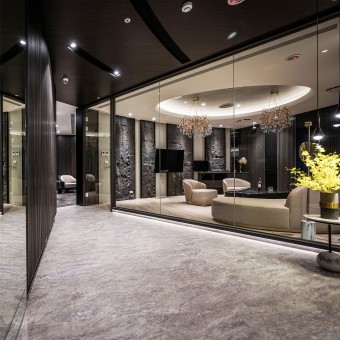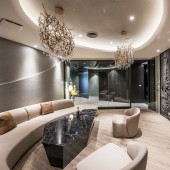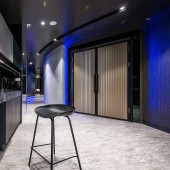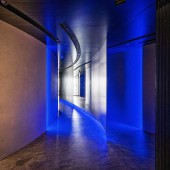
| THE AWARD |
| CATEGORIES |
| REGISTRATION |
| SUBMIT YOUR WORK |
| ENTRY INSTRUCTIONS |
| TERMS & CONDITIONS |
| PUBLICATIONS |
| DATES & FEES |
| METHODOLOGY |
| CONTACT |
| WINNERS |
| PRESS ROOM |
| GET INVOLVED |
| DESIGN PRIZE |
| DESIGN STORE |
| THE AWARD | JURY | CATEGORIES | REGISTRATION | PRESS | WINNERS | PUBLICATIONS | ENTRY INSTRUCTIONS |
Moon Light Basin Vip Lounge by Hsiang Kai Yang |
Home > Winners > Design #133733 >Interview |
 |
|
FS: What is the main principle, idea and inspiration behind your design?
HY: The primary source of inspiration for Moonlight Creek is the old Chinese convention. It is a traditional custom to place a cup of wine in a stream on a specified day for friends to enjoy, which later evolved into an elegant occasion where poets and wine are sung. This meaning is comparable to the owner’s wish to entertain guests; thus the designer used the cambered curve as a metaphor for a stream and encircled each party place with the stream.
FS: What has been your main focus in designing this work? Especially what did you want to achieve?
HY: The primary objective of this project is to determine how to maximize floor space efficiency in a long and narrow space. In other words, the required number of individuals can use audio-visual equipment in each place without interfering with one another.
FS: What are your future plans for this award winning design?
HY: I hope that this work can be shared on various online platforms so that Taiwan can be exposed to the world and emerging designers can learn from each other.
FS: How long did it take you to design this particular concept?
HY: 4. During a week of hand-drawing, the concept for the design gradually evolved.
FS: Why did you design this particular concept? Was this design commissioned or did you decide to pursuit an inspiration?
HY: This case was commissioned by the owner before the conception of the idea, and the design concept emerged gradually during the space planning process in response to the functional requirements.
FS: Is your design being produced or used by another company, or do you plan to sell or lease the production rights or do you intent to produce your work yourself?
HY: I believe this is also an example of intuition! Concurrently with the owner’s proposal for a guesthouse, I visualized the curve in my thoughts.
FS: What made you design this particular type of work?
HY: Having spent 15 years in the design service, I find the design process of each instance to be very noteworthy. Therefore, each case I have encountered has provided me with the best preparation for future design work.
FS: Where there any other designs and/or designers that helped the influence the design of your work?
HY: The designs of Carlo Alberto Scarpa consistently highlight the importance of craftsmanship and design. Every time I examine the work of Carlo Alberto Scarpa, I discover something fresh and unexpected. Because of Carlo Alberto Scarpa’s dedication to craftsmanship and design, I remind myself every time: don’t merely design for the sake of external look; instead, an outstanding design job must establish a balance between craftsmanship and design.
FS: Who is the target customer for his design?
HY: His clientele are individuals who value and respect craftsmanship and design.
FS: What sets this design apart from other similar or resembling concepts?
HY: It is not only the production of external form but also the formation of people’s true mental state in the place. The aim of people’s communication in the area determines the movement, lighting, and materials settings.
FS: How did you come up with the name for this design? What does it mean?
HY: As stated previously, the name Moonlight Creek is derived from the ancient Chinese folk custom of sharing a cup of wine with friends in a stream on a certain day. Therefore, the primary objective and concept of the name are to share excellent wine and delicious food and converse beneath the romantic moonlight.
FS: Which design tools did you use when you were working on this project?
HY: The concept was initially sketched on paper, and then the details were meticulously added using computer software.
FS: What is the most unique aspect of your design?
HY: Nesting the usage space and the buffer space of the moving line is a distinctive feature. Also, part of the communication between people can be carried out inside or in the buffered space of a moving line. The curved walls, cool lighting, and mirrors create an enchanted and seductive ambiance.
FS: Who did you collaborate with for this design? Did you work with people with technical / specialized skills?
HY: Design and development is a project I completed on my own. Once the designs are ready, I review the design concepts and substance with the renovation engineers, who then proceed with the construction. Meanwhile, they are professionals in a variety of fields, and we collaborate to communicate with each other and overcome building process issues.
FS: What is the role of technology in this particular design?
HY: Rather than the core value of technology, the most essential aspect of this scenario is the core value of project management. Since the entire project was intended to be completed within two months, meeting the deadline needed exceptional project management skills.
FS: Is your design influenced by data or analytical research in any way? What kind of research did you conduct for making this design?
HY: Throughout the design process, I experimented with various radii and angles of space utilization and investigated the sound field’s reflection. In one instance, I employed a concave and convex groove pattern on the wall so that sound was destroyed by the groove as it was conducted, and the echo problem caused by the curved space was much reduced.
FS: What are some of the challenges you faced during the design/realization of your concept?
HY: The most important factor is the case’s two-month design-to-completion timeframe.
FS: How did you decide to submit your design to an international design competition?
HY: 18. When we conquered the various obstacles and were congratulated by the owner, I believe that the team’s efforts should be recognized by a wider audience.
FS: What did you learn or how did you improve yourself during the designing of this work?
HY: I tried in the process of the design of the curve shape of space appearance. Among them, the three-dimensional curving ceiling shape caused the engineers a great deal of difficulty. We were able to resolve the issue through coordination and discussion with the engineers. This made me realize that the breakthrough of design is just 1% change, that we can only see the beautiful result by insisting on constant communication, as well as that we can only become the greatest asset of design by insisting on experience accumulation.
FS: Any other things you would like to cover that have not been covered in these questions?
HY: no
FS: Thank you for providing us with this opportunity to interview you.
A' Design Award and Competitions grants rights to press members and bloggers to use parts of this interview. This interview is provided as it is; DesignPRWire and A' Design Award and Competitions cannot be held responsible for the answers given by participating designers.
| SOCIAL |
| + Add to Likes / Favorites | Send to My Email | Comment | View Press-Release | Translations |




